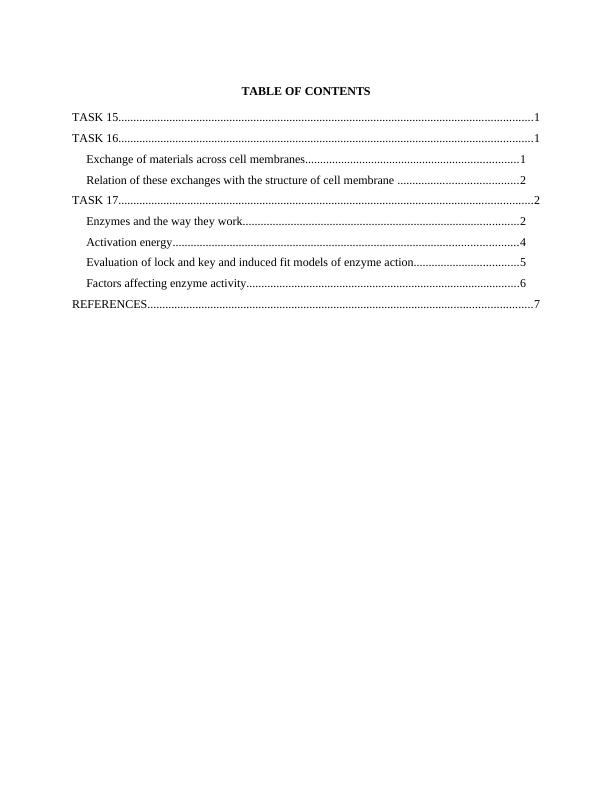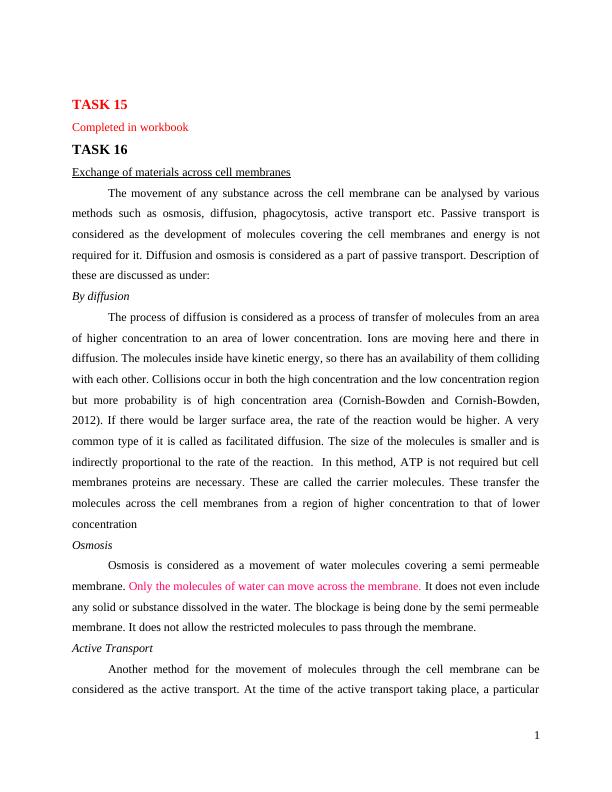Cell Biology and Biochemistry
Added on 2023-03-24
10 Pages1992 Words84 Views
Cell Biology and Bio chemistry

TABLE OF CONTENTS
TASK 15..........................................................................................................................................1
TASK 16..........................................................................................................................................1
Exchange of materials across cell membranes.......................................................................1
Relation of these exchanges with the structure of cell membrane ........................................2
TASK 17..........................................................................................................................................2
Enzymes and the way they work............................................................................................2
Activation energy...................................................................................................................4
Evaluation of lock and key and induced fit models of enzyme action...................................5
Factors affecting enzyme activity...........................................................................................6
REFERENCES................................................................................................................................7
TASK 15..........................................................................................................................................1
TASK 16..........................................................................................................................................1
Exchange of materials across cell membranes.......................................................................1
Relation of these exchanges with the structure of cell membrane ........................................2
TASK 17..........................................................................................................................................2
Enzymes and the way they work............................................................................................2
Activation energy...................................................................................................................4
Evaluation of lock and key and induced fit models of enzyme action...................................5
Factors affecting enzyme activity...........................................................................................6
REFERENCES................................................................................................................................7

TASK 15
Completed in workbook
TASK 16
Exchange of materials across cell membranes
The movement of any substance across the cell membrane can be analysed by various
methods such as osmosis, diffusion, phagocytosis, active transport etc. Passive transport is
considered as the development of molecules covering the cell membranes and energy is not
required for it. Diffusion and osmosis is considered as a part of passive transport. Description of
these are discussed as under:
By diffusion
The process of diffusion is considered as a process of transfer of molecules from an area
of higher concentration to an area of lower concentration. Ions are moving here and there in
diffusion. The molecules inside have kinetic energy, so there has an availability of them colliding
with each other. Collisions occur in both the high concentration and the low concentration region
but more probability is of high concentration area (Cornish-Bowden and Cornish-Bowden,
2012). If there would be larger surface area, the rate of the reaction would be higher. A very
common type of it is called as facilitated diffusion. The size of the molecules is smaller and is
indirectly proportional to the rate of the reaction. In this method, ATP is not required but cell
membranes proteins are necessary. These are called the carrier molecules. These transfer the
molecules across the cell membranes from a region of higher concentration to that of lower
concentration
Osmosis
Osmosis is considered as a movement of water molecules covering a semi permeable
membrane. Only the molecules of water can move across the membrane. It does not even include
any solid or substance dissolved in the water. The blockage is being done by the semi permeable
membrane. It does not allow the restricted molecules to pass through the membrane.
Active Transport
Another method for the movement of molecules through the cell membrane can be
considered as the active transport. At the time of the active transport taking place, a particular
1
Completed in workbook
TASK 16
Exchange of materials across cell membranes
The movement of any substance across the cell membrane can be analysed by various
methods such as osmosis, diffusion, phagocytosis, active transport etc. Passive transport is
considered as the development of molecules covering the cell membranes and energy is not
required for it. Diffusion and osmosis is considered as a part of passive transport. Description of
these are discussed as under:
By diffusion
The process of diffusion is considered as a process of transfer of molecules from an area
of higher concentration to an area of lower concentration. Ions are moving here and there in
diffusion. The molecules inside have kinetic energy, so there has an availability of them colliding
with each other. Collisions occur in both the high concentration and the low concentration region
but more probability is of high concentration area (Cornish-Bowden and Cornish-Bowden,
2012). If there would be larger surface area, the rate of the reaction would be higher. A very
common type of it is called as facilitated diffusion. The size of the molecules is smaller and is
indirectly proportional to the rate of the reaction. In this method, ATP is not required but cell
membranes proteins are necessary. These are called the carrier molecules. These transfer the
molecules across the cell membranes from a region of higher concentration to that of lower
concentration
Osmosis
Osmosis is considered as a movement of water molecules covering a semi permeable
membrane. Only the molecules of water can move across the membrane. It does not even include
any solid or substance dissolved in the water. The blockage is being done by the semi permeable
membrane. It does not allow the restricted molecules to pass through the membrane.
Active Transport
Another method for the movement of molecules through the cell membrane can be
considered as the active transport. At the time of the active transport taking place, a particular
1

End of preview
Want to access all the pages? Upload your documents or become a member.
Related Documents
Transport Processlg...
|5
|754
|330
Exchange of materials across the Cell Membranelg...
|7
|1510
|346
Exchange of Materials and Relation With Cell Membrane Structurelg...
|6
|1245
|304
Cell Structure & Function Compartments of the Body celllg...
|9
|2434
|254
Anatomy and Physiology Assignmentlg...
|11
|2293
|114
Biology Assignment- Diffusion and Osmosislg...
|5
|2021
|623
